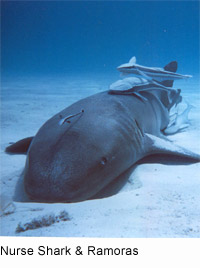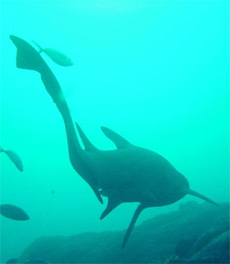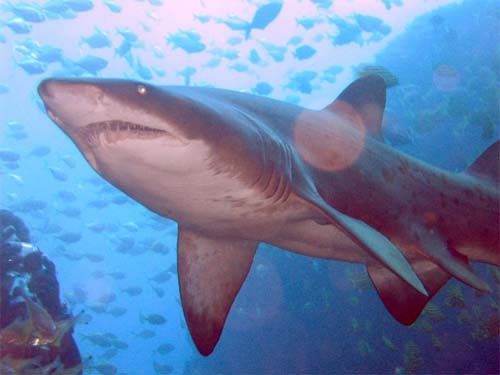|

 Weights and Measures: The largest species, called simply the nurse shark (Ginglymostoma
cirratum), may reach a length of 4.3 metres; the tawny nurse shark
(Nebrius ferrugineus) is somewhat smaller at 3.2 metres, and the
short-tailed nurse shark (Pseudoginglymostoma brevicaudatum) is
by far the smallest at just 75 centimetres in length. The first
of the three species may reach a weight of 110 kilograms. Weights and Measures: The largest species, called simply the nurse shark (Ginglymostoma
cirratum), may reach a length of 4.3 metres; the tawny nurse shark
(Nebrius ferrugineus) is somewhat smaller at 3.2 metres, and the
short-tailed nurse shark (Pseudoginglymostoma brevicaudatum) is
by far the smallest at just 75 centimetres in length. The first
of the three species may reach a weight of 110 kilograms.
Muscular Pecs: Yellowish
to dark brown in colour, nurse sharks have muscular pectoral fins,
two spineless dorsal fins (the second of which is smaller) in line
with the pelvic and anal fins, and a tail exceeding one quarter
the shark's body length.

Fleshy Barbels: The mouths of nurse sharks are most distinctive; it is far ahead
of the eyes and before the snout (sub-terminal), an indication of
the bottom-dwelling (benthic) nature of these sharks. Also present
on the lower jaw are two fleshy barbels, chemosensory organs which
help the nurse sharks to find prey hidden in the sediments. Behind
each eye is a very small circular opening called a spiracle, part
of the shark's respiratory system. The serrated teeth are fan-shaped
and independent; like other sharks, the teeth are continually replaced
throughout the animal's life.
 Night Nurse: Nurse sharks are nocturnal animals, spending the day in large inactive
groups of up to 40 individuals. Hidden under submerged ledges or Night Nurse: Nurse sharks are nocturnal animals, spending the day in large inactive
groups of up to 40 individuals. Hidden under submerged ledges or
in crevices within the reef, the nurse sharks seem to prefer specific
haunts and will return to them every day.
By night, the sharks are
largely solitary; they spend most of their time rifling through
the bottom sediments in search of food. Their diet consists primarily
of crustaceans, molluscs, tunicates, and other fish, particularly
stingrays.
On the Menu: Nurse sharks are thought to take advantage of dormant fish which
would otherwise be too fast for the sharks to catch; although their
small mouths limit the size of prey items, the sharks have large
throat cavities which are used as a sort of bellows valve. In this
way nurse sharks are able to suck in their prey like a vacuum. Nurse
sharks are also known to graze algae and coral.

Birds and Bees: The mating season runs from late June to the end of July. Nurse
sharks are ovoviviparous, meaning the eggs develop and hatch within
the body of the female, where the hatchlings develop further until
live birth occurs. The gestation period is six months, with a typical
brood of 30-40 pups. The mating cycle is biennial, as it takes 18
months for the female's ovaries to produce another batch of eggs.
The young nurse sharks are born fully developed at about 30 centimetres
long in Ginglymostoma cirratum. They possess a spotted coloration
which fades with age.

All text is available under the terms
of the GNU Free Documentation License
|